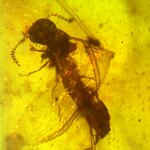Ecology & Zoology

The International Institute for Species Exploration at Arizona State University and an international committee of taxonomists – scientists responsible for species exploration and classification – today announce the top 10 new species described in 2008.
The taxonomists also are issuing an SOS – State of Observed Species – report card on human knowledge of Earth's species. In it, they report that 18,516 species new to science were discovered and described in 2007. The SOS report was compiled by ASU's International Institute for Species Exploration in partnership with the International…

The International Institute for Species Exploration at Arizona State University and an international committee of taxonomists – scientists responsible for species exploration and classification – today announce the top 10 new species for 2009, consisting of those described in 2008.
On the list are a pea-sized seahorse, caffeine-free coffee and bacteria that live in hairspray. The top 10 new species also include the very tiny (a snake just a slither longer than 4 inches or 104 millimeters), the very long (an insect from Malaysia with an overall length of 22.3 inches or 56.7 centimeters) the…

A new study has shown that the effectiveness of the Komodo Dragon bite is a combination of highly specialized serrated teeth and venom and the authors say this dismisses the widely accepted theory that prey die from septicemia caused by toxic bacteria living in the dragon's mouth.
Using sophisticated medical imaging techniques, an international team led by Dr Bryan Fry from the University of Melbourne have revealed that the Komodo Dragon (Varanus komodoensis) has the most complex venom glands yet described for any reptile, and that its close extinct relative Megalania was the largest venomous…

Before the days of mandatory underseat pet carriers, my airline colleagues received a call from a woman who needed to bring her therapy pet, a pig, on a flight. The airline didn’t see a problem, since Vietnamese pot-bellied pigs are about the size of dogs and just as well behaved. However, the animal that the woman showed up with was no potbellied pig. On the day of the flight, the woman showed up with a 300 pound barnyard pig on a leash. The pig took up the entire aisle, calmly sleeping through the flight.
Perhaps the woman wouldn't have inconvenienced any bathroom-bound…

When bees collect nectar, how do they hold onto the flower? Cambridge University scientists have shown that it is down to small cone-shaped cells on the petals that act like 'velcro' on the bees' feet.
New research, published online in today's Current Biology, shows that bumblebees can recognise the texture of petal surfaces by touch alone. More importantly, they choose to land on petals with conical cells that make it easier to grip, rather than on flat, smooth surfaces. With this extra grip, they can extract nectar from the flower more efficiently.
In the natural world, bees can…

Dartmouth Medical School geneticists say they have made new inroads into understanding the regulatory circuitry of the biological clock that synchronizes the ebb and flow of daily activities, according to two studies published May 15.
Research on the relationship between clocks and temperature, reported in Cell, offers insight into a longstanding puzzle of temperature compensation: why the 24-hour circadian rhythm does not change with temperature when metabolism is so affected. A related study, in Molecular Cell, tracks a clock protein in action, mapping hundreds of highly…
I decided to go ahead and start with this one, as the rest of my research material is all on my laptop and said laptop is not hooked up to the internet while my home computer is. Plus, this article was the one that finally inspired me to write a blog, the straw that broke the camel's back, if you will, because I read and started to write about it, then realized that I was tired of doing all this research and writing that nobody was getting to read.This morning, I got on the internet as I do most every morning to look at the current events, and what should my eyes behold but the heading "The…

Recently I had the opportunity to ask Paul Ewald, one of the nation's leading evolutionary biologists, about a subject near and dear to his heart: the evolution of a bug, specifically swine flu. As usual, Ewald, a professor of biology at the University of Louisville, was lucid, cogent and memorable. In his 2002 book, Plague Time: The New Germ Theory of Disease, Ewald set the bio-med community on its head by arguing that most chronic disease is caused by sub-acute levels of pathogenic origin, rather than genes. His thesis has since generated enormous interest and a growing following in…

Rare traits persist in a population because predators detect common forms of prey more easily. Researchers writing in BMC Ecology found that birds will target salamanders that look like the majority – even reversing their behavior in response to alterations in the ratio of a distinguishing trait.
Benjamin Fitzpatrick, from the University of Tennessee, worked with Kim Shook and Reuben Izally to study the effects of the prevalence of a dorsal stripe among a group of model salamanders on the foraging behavior of a flock of Blue Jays. He said, "Maintenance of variation is a classic paradox…